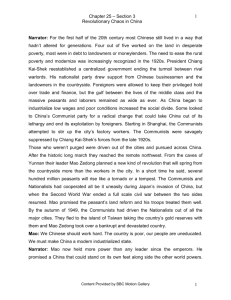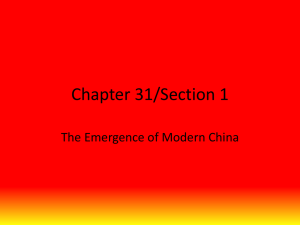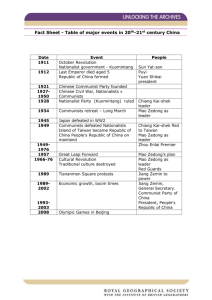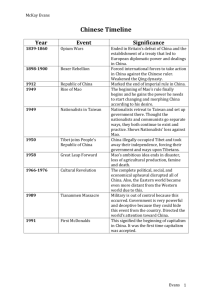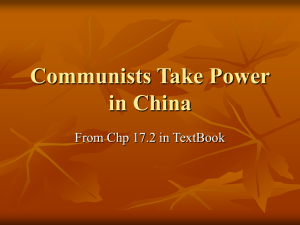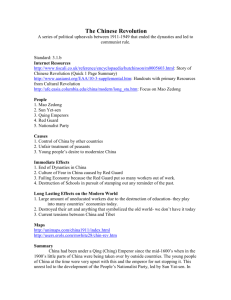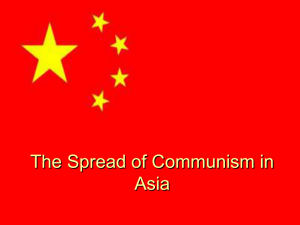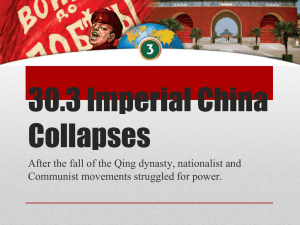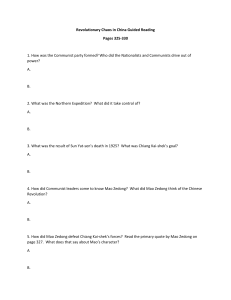The Chinese Revolution
advertisement
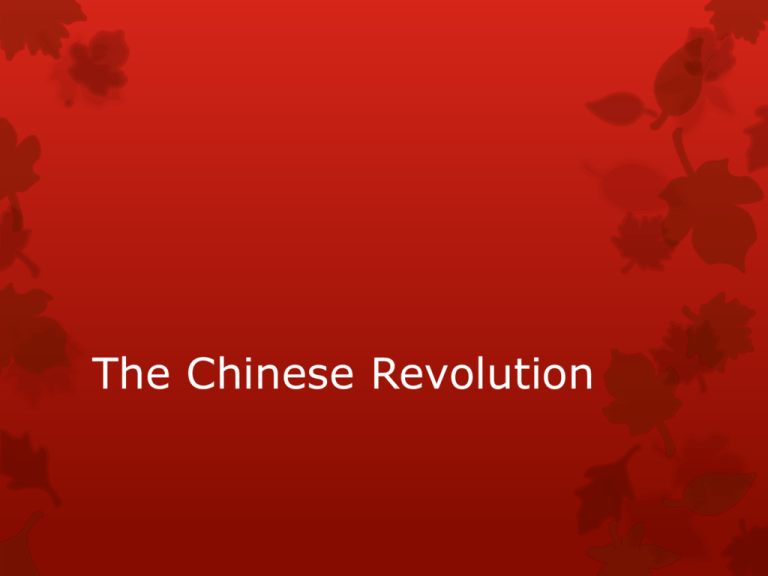
The Chinese Revolution Essential Question How did the Communist Party of China take power? Introduction 1912 – Qing Dynasty ends, & long struggle to establish new government begins Universities provided theoretical foundation for political reconstruction Secret societies plotted to restore Chinese Emperor Japan & Europe wanted to divide China into imperial zones Revolution in China Revolutionary Alliance opposed Qing Dynasty in 1911 Claimed right to establish government, but lacked the power to do so Revolutionary Alliance elected president, but warlords continued to dominate Yuan Shikai, most powerful warlord, tried to take power, plans interrupted by Japanese intervention Revolution in China 1915 – Japan presented Shikai with 21 Demands, he tried to ignore them Another warlord opposed Japan more strongly, Shikai was overthrown In the chaos Japan seized control of northern China May 4th Movement May 4, 1919 – Massive demonstrations protested invasion by Japanese Movement was meant to create liberal democracy Called for abandonment of Confucianism in favor of Western ideals Led to emergence of Communism in China Russian Influence Russian Revolution served as model for possible reform in China Marxist groups started in universities & coastal cities Founded Socialist Youth Corps in 1920 1921 – Marxist leaders met in Shanghai & formed Communist Party of China Seizure of Power by the Guomindang 1919 – Sun Yat-sen tried to revitalize reform movement by creating Nationalist Party of China (Guomindang) Militarized in order to drive out warlords Power came from commercial groups, warlords, & criminal organizations Yat-Sen formed alliance with Communist Party in 1924 Seizure of Power by the Guomindang Nationalist Party received support from Soviet Union Chiang Kai-Shek became associate of YatSen Chaotic economic situation got worse Failure to address problems of peasants hurt Nationalists Mao & the Peasant Option Mao Zedong was a peasant, but joined nationalist movement Influenced by Marxists, saw peasants as key to successful revolution Rose to power in Communist Party after a split between Nationalists & Communists 1925 – Yat-sen died, Kai-Shek began to expand Nationalist territory Mao & the Peasant Option 1927 – Seized Shanghai, later captured Beijing & was seen as most powerful leader in China Kai-Shek was most influential warlord, ruthlessly eliminated rivals Kai-Shek’s army eliminated all Communists in Shanghai Purges spread to other cities, & caused civil war between Nationalists & Communists Communist Victory Nationalists supported by businesses, intellectuals, landlords, & military Kai-Shek asked West for support against Communists, but only Soviet Union helped Mao started Communists movement, but was forced to Northwest China by Nationalists 1937 – Japan invaded China Communist Victory Nationalists continued to attack Communists until they had to unite to confront Japanese Japanese defeated Kai-Shek’s army, Communists successfully attacked Japanese & regained much of northern China Nationalists confined to northern cities, & Communists had upper hand after WW2 Communist Victory Mao drove Nationalists to Taiwan in 1949 Proclaimed “People’s Republic of China” Key to Success – Program of rural reform Mao concentrated on social & economic reform for peasants, which gained him many supporters Mao’s China Communists took control of a unified country Government had strong political & military organization People’s Liberation Army accepted the Communist Party’s Leadership China’s power grew, & they eventually split with the Soviet Union Economic Growth & Social Justice 1950-1952 – Land redistributed to peasants Communists’ goal was industrialization, just like in Russia Mao introduced the Mass Line approach, which brought peasants together in production groups Mao introduced the Great Leap Forward in 1958 Economic Growth & Social Justice Industrialization was based in rural communities rather than urban factories Immediate consequences were disastrous Famine & falling production Population grew fast, which increased economic problems Government limited families to 1 child Mao removed from office in 1960 Women’s Role in China Mao’s programs increased the status of women Nationalists failed to support women’s rights, so many women turned to Communism Communist Party used women as teachers, laborers, soldiers, & some had influence in the government Communist victory brought full legal rights to women Mao’s Last Campaign Launched Cultural Revolution in 1965 Student demonstrators began mass criticism of Mao’s political enemies, called pragmatists Support grew in army, but pragmatists regained control of government “The Gang of Four” attempted to continue the revolution until Mao’s death in 1976 Mao’s Last Campaign Military & pragmatists arrested Gang of Four, & forced them out of the Communist Party Pragmatists opened China to Western influence Chinese have been the most successful revolutionary regime at redistributing wealth Standard of living increased, & industrial & agricultural sectors have been more productive
